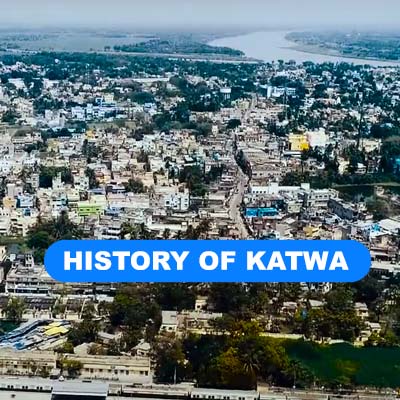

The small town has a historical background of five hundred years. The earliest name of Katwa was Indranee Pargana. Later the name was changed to Kantak Nagari. In January 1510, Sri Chaitanya Mahaprabhu received “Diksha” from his guru Kesava Bharati at the site of the current Sri Gauranga Bari Temple in Katwa. Since then, this small township has been a sacred place for Vaishnavites.
The location of the town at the confluence of two navigable rivers, Ajay and Hooghly, made the town strategically important. Katwa was considered the gateway to Murshidabad, the erstwhile capital of the subah of Bengal. Nawab Murshid Quli Khan, Nawab of Bengal, first established a chowki at Katwa during his reign (1717-1727). Between 1742 and 1751, Katwa was invaded by the Bargis (break-away Maratha groups) several times, as part of the Maratha invasions of Bengal.[7][8] It was the site of the First Battle of Katwa (1742) and the Second Battle of Katwa (1745), with Nawab Alivardi Khan of Bengal defeating the Marathas both times. In the Battle of Plassey (1757), on 19 June 1757, Katwa was the last Nawabi garrison conquered by British forces before heading to Plassey. Robert Clive held a council of war in Katwa on 21 June 1757, where the decision was taken to cross the Hooghly River to Plassey. On 19 July 1763, Katwa was once again the scene of action during the Third Battle of Katwa, where British troops fought and defeated a contingent of troops loyal to Nawab Mir Qasim.
Under the aegis of the British East India Company, Katwa became an urban settlement, encouraged by the presence of missionaries such as William Carey Jr., the son of William Carey.[10][11] By the 1800s, Katwa had become a thriving trading town with the principal economic activity being the riverine trade in salt. The modern town of Katwa was established in 1850, when it was granted the status of a subdivisional town under the 10th Act of Municipal Rules. The Municipality of Katwa as a governing entity was established on 1 April 1869.[13] The urbanization of Katwa received a further boost with the construction of railroads in the early 20th century: Katwa-Azimganj (constructed in 1903), Katwa-Bandel (1912), Katwa-Bardhaman (1915), Katwa-Ahmedpur (1917).
Katwa and its surrounding areas are especially well known for their raucous Kartik Puja, colloquially known as Kartik Ladai (Ladai means “battle” in Bengali). The object of worship is the boy-faced deity, Kartik, locally referred to as Nangto Kartik or Naked Kartik, in reference to the youth of the deity. In the greater Katwa area, over 250 separate organizations organize pujas and unofficially compete with each other over the sophistication of the theme or the sculpture of the deity After the day of the puja, the deities are paraded throughout town on their way to be ritually submerged in the nearby Hooghly River. The processions usually feature loud music and dancing, leading to a town-wide, festival-like ambiance (jovially named ladai or battle) enjoyed by all participants and spectators.